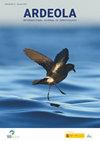Sex Ratio of Alpine and Pyrenean Rock Ptarmigans Lagopus muta Estimated by a Non-Invasive Method (Faecal DNA Analysis) and from Hunting Bag Data
IF 1.2
4区 生物学
Q2 ORNITHOLOGY
引用次数: 0
Abstract
In most unisexual species, the numbers of male and female individuals are approximately equal. The adult sex ratio (ASR) is a key demographic parameter for the conservation and management of wild species. However, in the case of monomorphic birds such as the Rock Ptarmigan Lagopus muta, estimating the sex ratio is difficult. To test if the sex ratio is balanced, we analysed the adult sex ratio of this tetraonid with two different methods, using microsatellite individualisation of non-invasive samples (faeces) and the hunting bag data of birds hunted in the French Alps and Pyrenees. The results of our non-invasive study revealed a balanced ASR in spring, whereas hunted specimens had a strongly male-biased ratio for adults but an approximately balanced sex ratio for juveniles (< 1 year old). The sex ratio estimated from hunting data may be biased for the adult population and, as occurs in other species, is not representative of the overall sex ratio. Our results suggest that, assuming our sampling strategy was adequate, non-invasive sampling is a good method to estimate ASR.—Aleix-Mata, G., Perez, J.M., Adrados, B., Boos, M., Marty, E., Mourieres, P., Lauer, E., Zimmermann, S., Mossoll-Torres, M. & Sanchez, A. (2021). Sex ratio of Alpine and Pyrenean Rock Ptarmigans Lagopus muta estimated by a non-invasive method (faecal DNA analysis) and from hunting bag data. Ardeola, 68: 201-212.用非侵入性方法(粪便DNA分析)和猎袋数据估算高山和比利牛斯山岩雷鸟的性别比
在大多数单性物种中,雄性和雌性个体的数量大致相等。成虫性别比(ASR)是野生物种保护与管理的重要人口统计学参数。然而,对于单态鸟类,如岩雷鸟,估计性别比例是困难的。为了测试性别比例是否平衡,我们用两种不同的方法分析了这种四足动物的成年性别比例,使用非侵入性样本(粪便)的微卫星个别化和在法国阿尔卑斯山和比利牛斯山脉捕获的鸟类的狩猎袋数据。我们的非侵入性研究结果显示,春季的ASR是平衡的,而被猎杀的标本在成年中具有强烈的雄性偏倚比例,而在幼体(< 1岁)中则具有近似平衡的性别比例。从狩猎数据估计的性别比可能对成年种群有偏差,并且,正如在其他物种中发生的那样,不能代表总体性别比。我们的研究结果表明,假设我们的采样策略是适当的,非侵入性采样是估计ASR的好方法。- alex - mata, G., Perez, j.m., Adrados, B., Boos, M., Marty, E., Mourieres, P., Lauer, E., Zimmermann, S., Mossoll-Torres, M. & Sanchez, A.(2021)。用非侵入性方法(粪便DNA分析)和狩猎袋数据估计阿尔卑斯和比利牛斯山岩雷鸟的性别比。中国生物医学工程学报,28(6):201-212。
本文章由计算机程序翻译,如有差异,请以英文原文为准。
求助全文
约1分钟内获得全文
求助全文
来源期刊
CiteScore
2.30
自引率
6.20%
发文量
16
审稿时长
>12 weeks
期刊介绍:
Ardeola: International Journal of Ornithology is the scientific journal of SEO/BirdLife, the Spanish Ornithological Society. The journal had a regional focus when it was first published, in 1954. Since then, and particular during the past two decades, the journal has expanded its thematic and geographical scope. It is now a fully international forum for research on all aspects of ornithology. We thus welcome studies within the fields of basic biology, ecology, behaviour, conservation and biogeography, especially those arising from hypothesis-based research. Although we have a long publication history of Mediterranean and Neotropical studies, we accept papers on investigations worldwide.
Each volume of Ardeola has two parts, published annually in January and July. The main body of each issue comprises full-length original articles (Papersand Review articles) and shorter notes on methodology or stimulating findings (Short Communications). The publication language is English, with summaries, figure legends and table captions also in Spanish. Ardeolaalso publishes critical Book Reviewsand PhD-Dissertation Summaries; summarising ornithological theses defended in Spain. Finally there are two Spanish-language sections, Ornithological News; summarising significant recent observations of birds in Spain, and Observations of Rare Birds in Spain, the annual reports of the Spanish Rarities Committee.

 求助内容:
求助内容: 应助结果提醒方式:
应助结果提醒方式:


